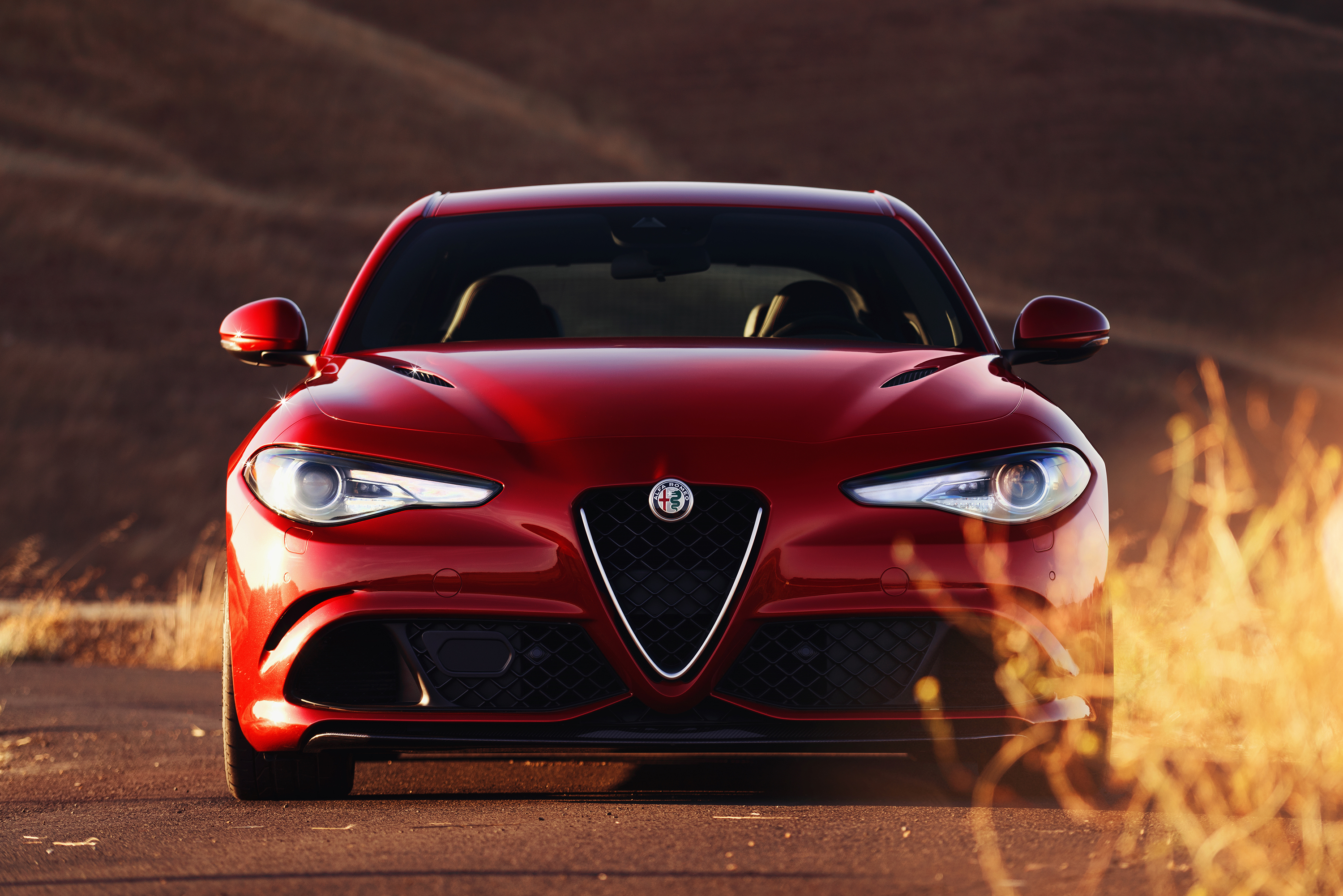
Brand Deep Dive: Alfa Romeo
Alfa’s back, and they’re ready to rumble
By Randy Lioz, Editor, Car-ED.com | June 2018
The Alfa Romeo brand—say “Alfa Ro-MAY-o”—has over 100 years of history, with a strong heritage of racing and sports cars. It’s the marque that gave Enzo Ferrari his big break before he started his own company. Jeremy Clarkson, the prominent BBC and Amazon automotive TV host, said, “you can’t be a true petrolhead until you’ve owned an Alfa Romeo.” And its badge was affixed to the hood of the flashy red convertible that Dustin Hoffman drove in The Graduate, cementing its identity in the minds of American consumers.
What does this brand stand for?

Image credit: FCA
Alfa Romeo has always been about sportiness. From nearly the beginning, ALFA, which stands for Anonima Lombarda Fabbrica Automobili, was involved in auto racing, which helped to set its course through history. For most of that time it hewed to the performance car standard of rear-wheel drive, though more recently the brand’s offerings had been built with the more cost-effective front-wheel drive layout, particularly for its small hatchbacks. These were never sold in the U.S., however.
Alfa has been owned by Fiat since 1986, being positioned as a step up from that more affordable Italian brand. The company’s Maserati marque competes in the higher reaches of the luxury market, while Ferrari represents the ultimate destination for Italian car fans.
Is it new to the U.S. market?
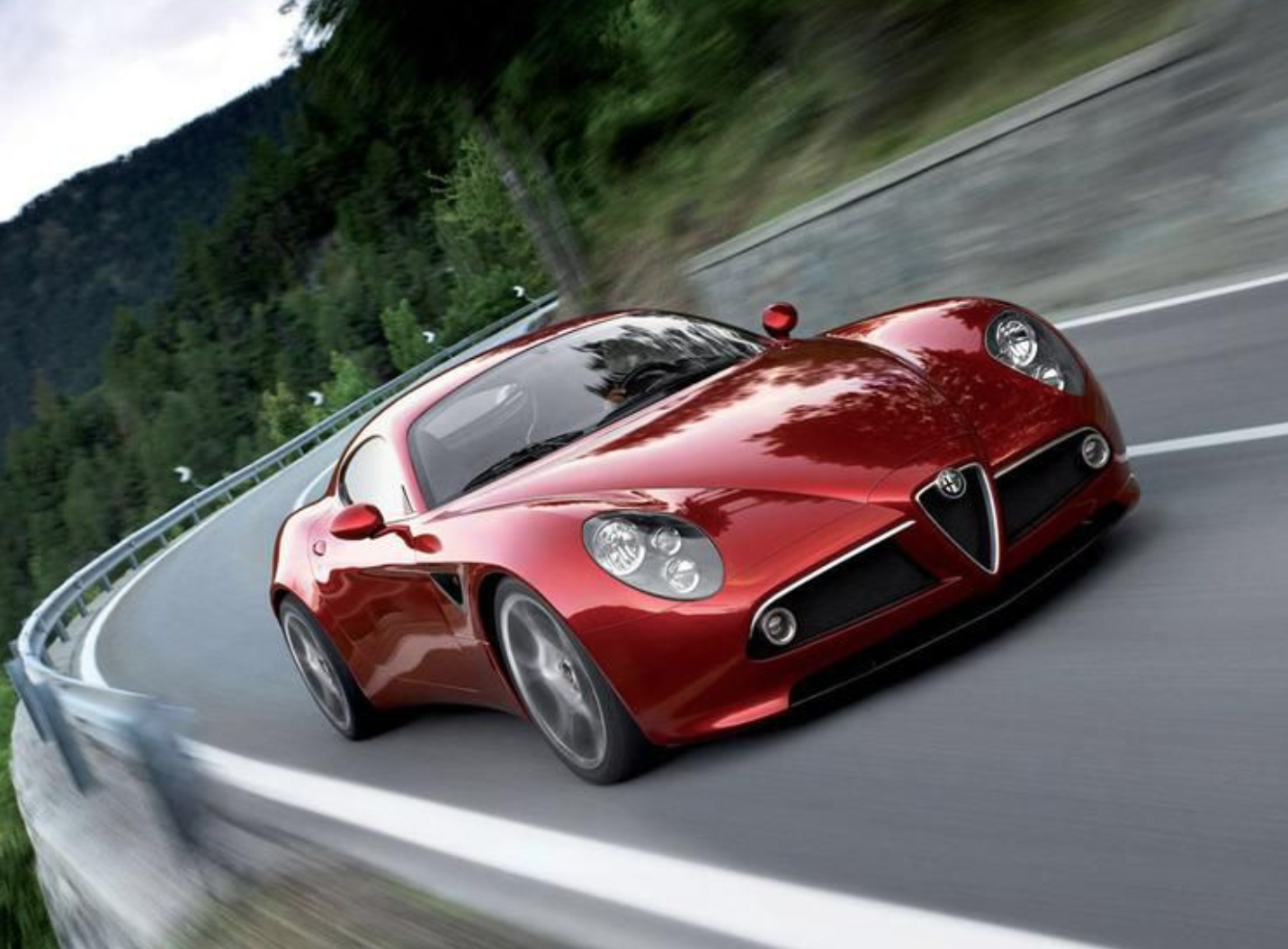
Photo credit: FCA
Well, sort of. Alfa returned to the U.S. market in 2008—after a hiatus of over a decade—with a single high-end sports car, the 8C Competizione, selling just 84 copies at $240,000 per. As Fiat took ownership of American manufacturer Chrysler, Alfa’s plans for a more serious Stateside return accelerated.
The first car within reach of the rest of us was the 4C, a sensuously styled little 2-seater that arrived, snarling and raw, in 2014. With a tiny bit of sound deadening and whole lot of road feel, it isn’t a car for everyone, and was never intended as such. But it started the enthusiast world buzzing with anticipation for what would come next.
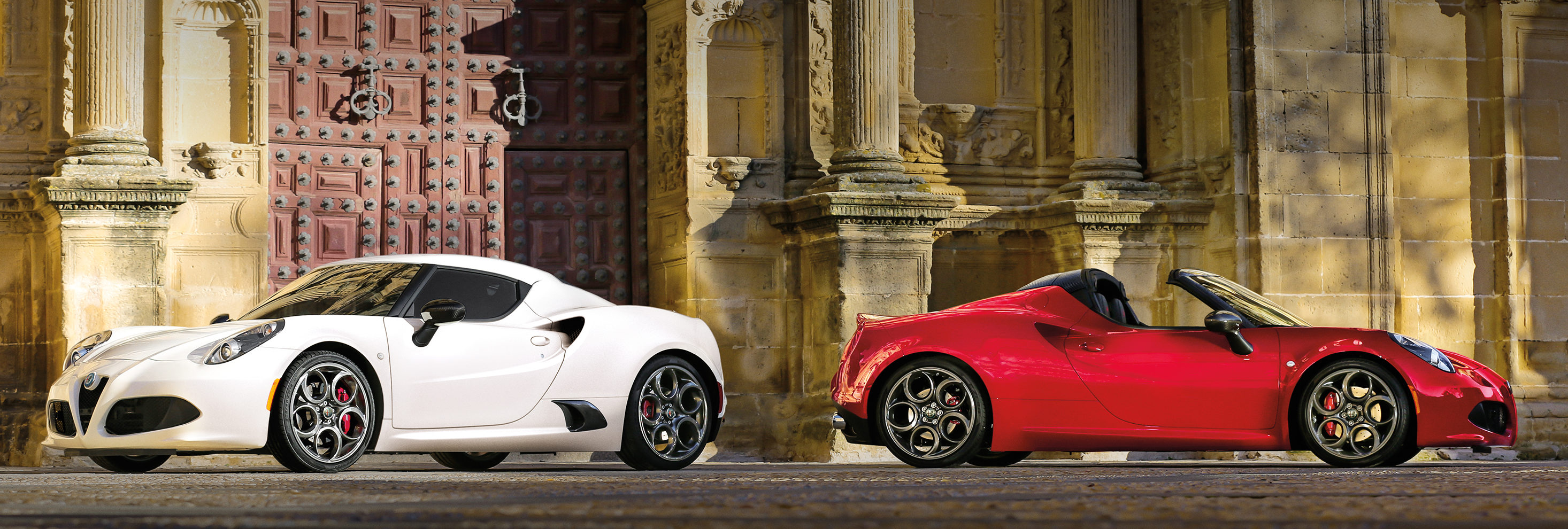
2018 Alfa Romeo 4C (left) and Alfa Romeo 4C Spider (right), photo credit: FCA
The Giulia
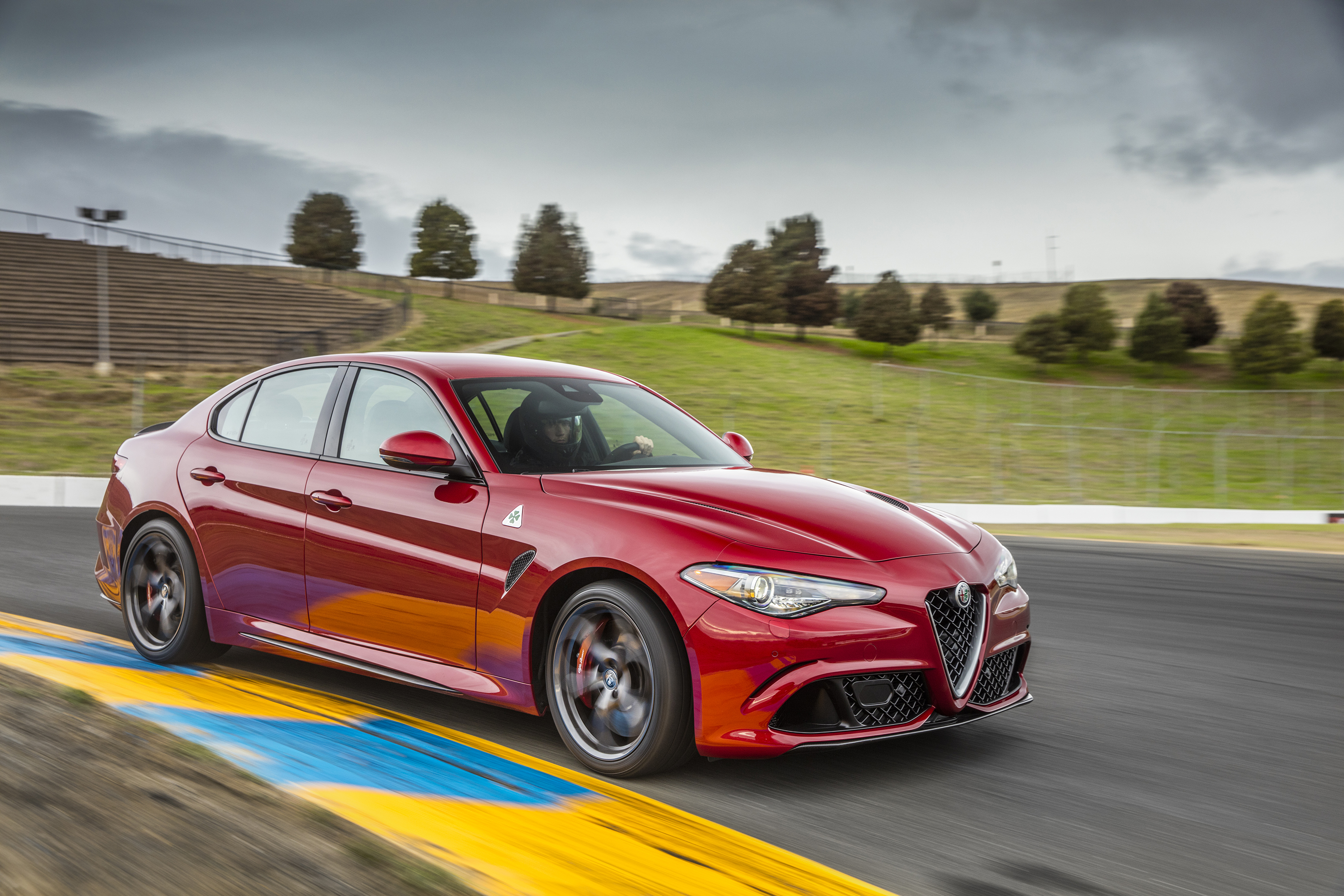
2017 Alfa Romeo Giulia Quadrifoglio, photo credit: FCA
If the brand was to get serious about success in the American market, it would have to deliver something more mainstream. The Alfa Romeo Giulia was the next car down the pike, and it’s a wallop. You can check out Nick Kurczewski’s review of the Giulia Ti RWD here. Aimed squarely at the BMW 3-Series, the best-selling luxury car in history, the Giulia is a rear-wheel drive performance sedan in the entry luxury segment. It’s identical in length to the current 3-Series, while nearly identical in height, and a couple inches wider.
Because the Giulia aims to reestablish Alfa as a performance luxury brand that can make hearts race, the first version released was the M3-fighting Quadrifoglio—it carries Alfa’s 4-leafed clover performance badge on its front fenders. This car trumps the BMW’s 444-hp turbo six with a 505-hp turbo six of its own, and an 8-speed transmission that bests the German’s 7-speed unit.
In a highly anticipated four-way comparison conducted by Car and Driver that included the M3, as well as the Cadillac ATS-V and the Mercedes-AMG C63 S, the Alfa placed first. The magazine declared that the Giulia Quadrifoglio had “class-leading ride, handling, steering feel, and power.”
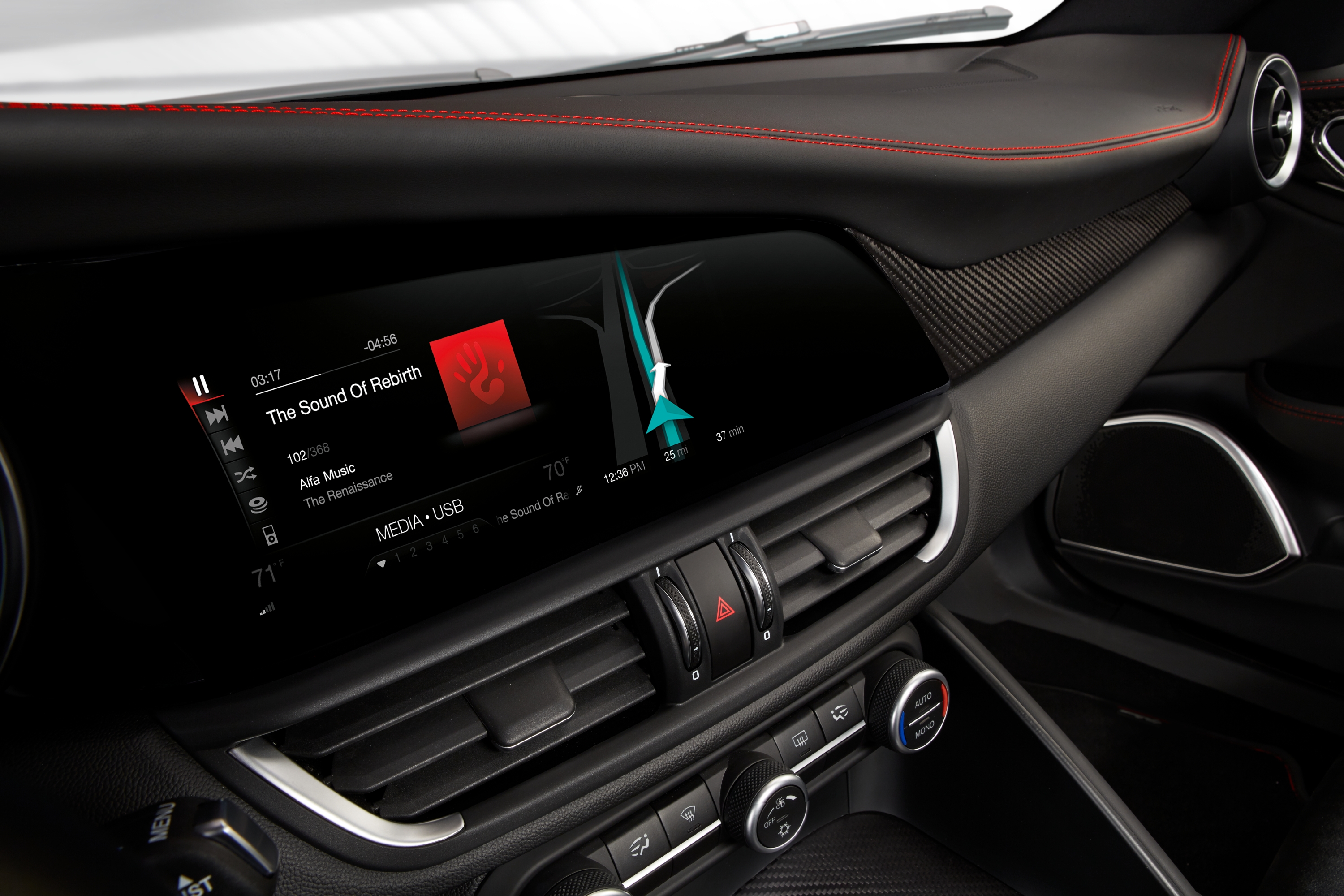
2017 Giulia Quadrifoglio interior, photo credit: FCA
On the other hand, C/D pointed out the elephant in the room: Alfa’s build quality. When the brand exited the US market in 1995, it was plagued with a reputation for quality gremlins. Unfortunately for Alfa, those demons don’t seem to have been fully exorcised in the intervening years. Reports of quality issues continue to hit press reports, including Car and Driver’s issue during this comparison, where the remote start feature consistently led to a check engine light. And Consumer Reports has had consistent issues with its tester as well.
The fact that C/D was willing to overlook these issues is telling. Alfa Romeo is a brand that appeals to enthusiasts, and this group is often willing to live with quality compromises to attain a transcendent driving experience.
To make as big a splash as possible, Alfa paired the debut of this car with three ads during the 2017 Super Bowl, promising to shake up the expectations of American consumers in the luxury market.
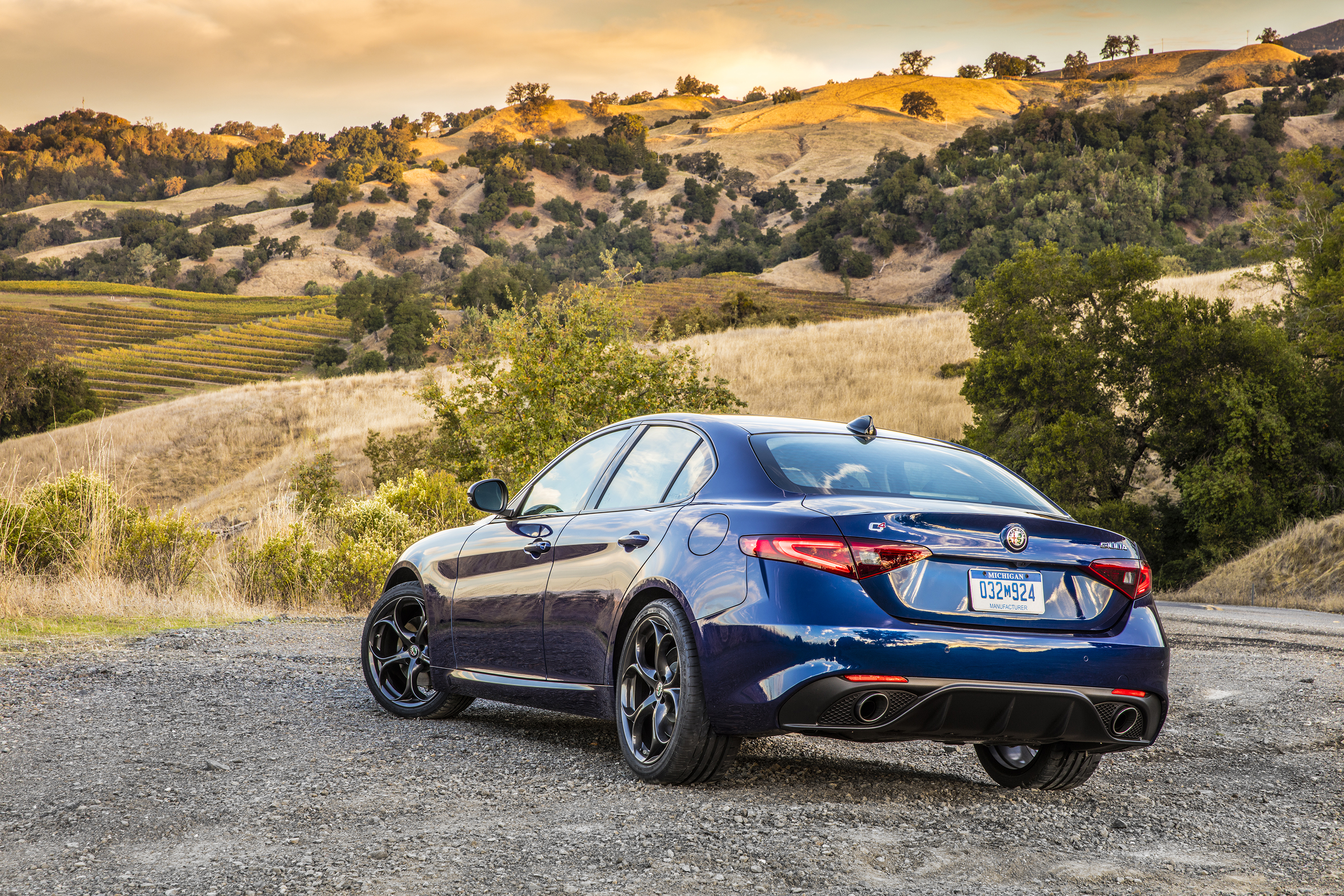
2018 Alfa Romeo Giulia Ti, photo credit: FCA
Alfa continued the rollout of the Giulia line with other models that line up against the 3-series range. The base Giulia aligns well against the 330i, matching its 2.0-liter turbo engine, but bringing 280 hp to the fight against the BMW’s 248, while undercutting the German’s pricing by $2,000.
The Giulia has also set the tone for Alfa’s trim lineup, with a Ti trim positioned between the base car and the hyper Quadrifoglio. The Ti is focused on sprucing up the car’s appearance inside and out, with wood trim, and upgraded infotainment screen of 8.8” (versus the base 6.5” screen), larger wheels, and more equipment availability; you can equip the Ti with items like an active suspension and Harman Kardon stereo.
The car makes a strong case for itself in the styling department, with gorgeous flowing lines, classic proportions, and a front end defined by Alfa’s heritage V-shaped shield grille. And it continues to rack up awards, earning both Motor Trend Car of the Year and Car and Driver 10Best for 2018. With the Giulia off to a good start, Alfa is now on to the next step in its brand rollout in the U.S.
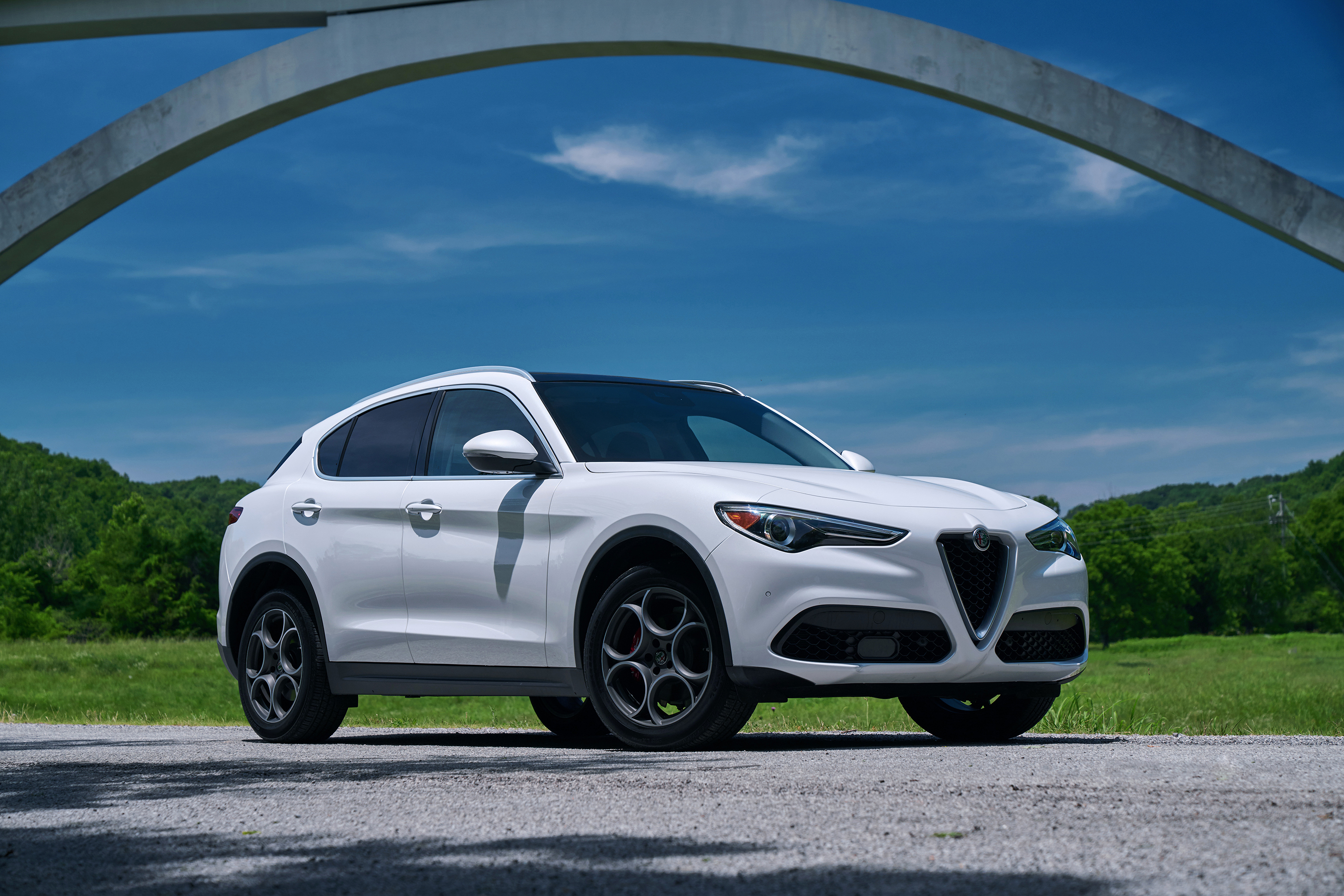
The Stelvio
Since the U.S. car market has shifted towards utility vehicles, this was the next natural step for Alfa Romeo. But with its sports car heritage, Alfa wanted to ensure that even its SUV drivers want for nothing in the performance department. So the Stelvio—named for the famous Stelvio Pass in Northern Italy, with its 48 hairpin turns—represents one of the best handling SUVs on the market.
The Stelvio is based on the same platform as the Giulia, with the same wheelbase, but with a ride height raised several inches and a wider track width. The crossover managed to retain a 50/50 weight distribution between front and rear, while using aluminum for several body panels to keep the weight gain to a minimum.
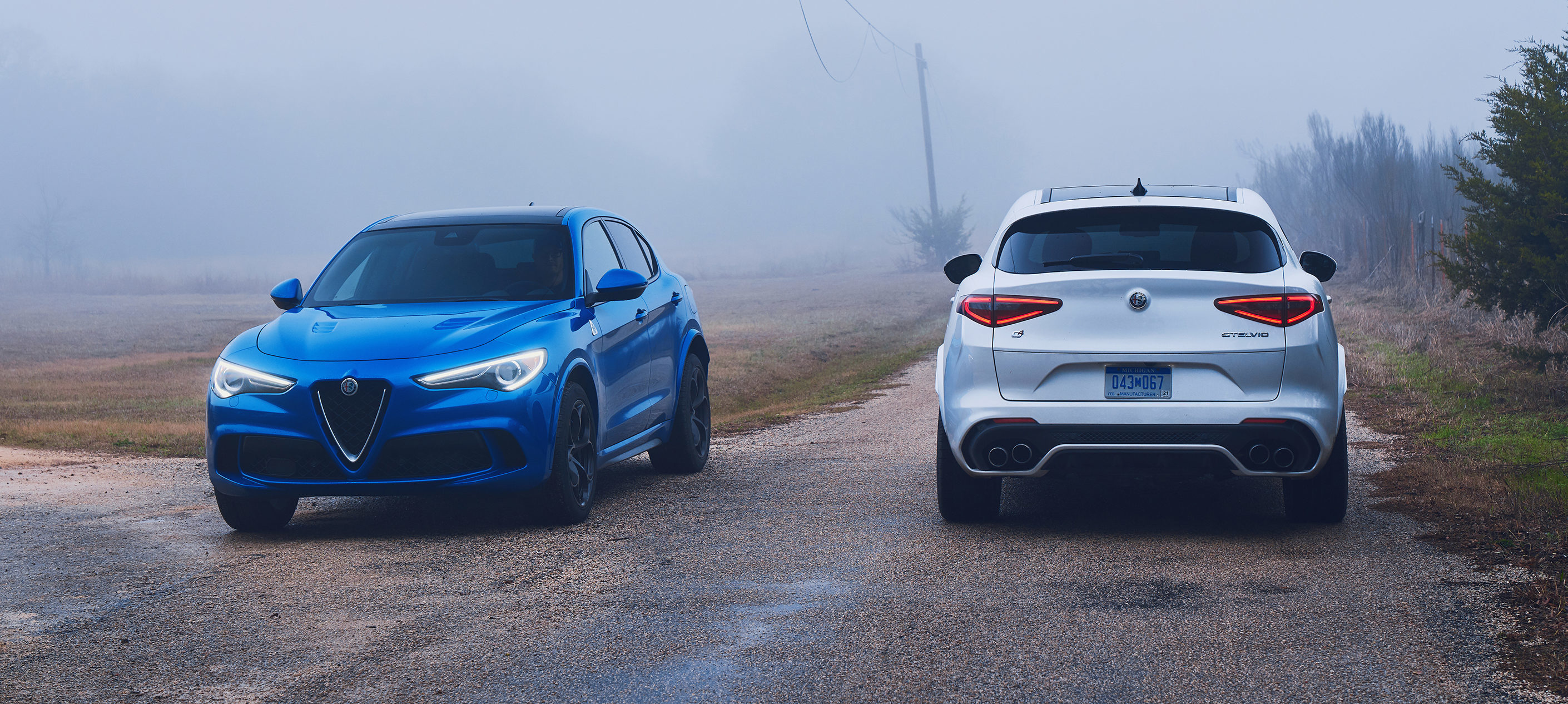
2018 Alfa Romeo Stelvio Quadrifoglio in Misano Blue and Trofeo White, photo credit: FCA
The Stelvio’s powertrain lineup is identical to the Giulia’s, setting up a favorable comparison against some impressive competitors, like the Porsche Macan. While starting nearly $6,000 less, the Stelvio can hit 0-60 mph in a claimed 5.4 seconds, nearly a full second faster than the Porsche’s time. Even with its higher horsepower and slight weight disadvantage versus the Macan, the Stelvio gets 2-3 mpg better.
And of course the Stelvio also offers Ti and Quadrifoglio versions, with the latter being just as extreme as its sedan counterpart.
What does the future hold for Alfa?
In order to build upon this lineup, Fiat Chrysler must keep pushing forward aggressively, and the company recently laid out plans to do just that. It plans to bring four more models to the U.S. by 2022, including two utilities that will bookend the Stelvio in size, and two high-performance cars.
The utility vehicle that slots below the Stelvio will compete with the likes of the BMW X1, Audi Q3, Mercedes GLA and Lexus UX. Above it will be a full-sized utility that goes against the BMW X5 and the large array of competitors from nearly every luxury brand.
The brand also intends to resurrect its storied GTV—or “Gran Turismo Veloce”—nameplate, for a 4-seater coupe expected to hit 600 hp with an E-Booster electric turbocharger. And on the top end will be an exotic, mid-engined and hybrid-powered 8C, whose 700-hp e-AWD drivetrain should help bring it to 60 mph in under 3 seconds.
Speaking of electrification, all of these vehicles are expected to offer plug-in hybrid capability, at least as an option. And they’ll be sure to protect for a future of autonomous driving, with Level 2 or 3 capability built in.
Interesting facts about Alfa Romeo
- Alfa was first brought to the U.S. in 1955 by prominent importer Max Hoffman, who convinced the company to create a droptop Spider version of its Giulietta coupe. That car was part of a post-war wave of sporty cars from the Continent that had a big impact on American tastes.
- The 1966 Alfa Romeo Spider driven by Dustin Hoffman in The Graduate set off a sales boom for the brand in the U.S. The Spider survived as a model until 1994, the year before Alfa left the American market, and the company even did a special Graduate edition in the ‘80s to honor the appearance.
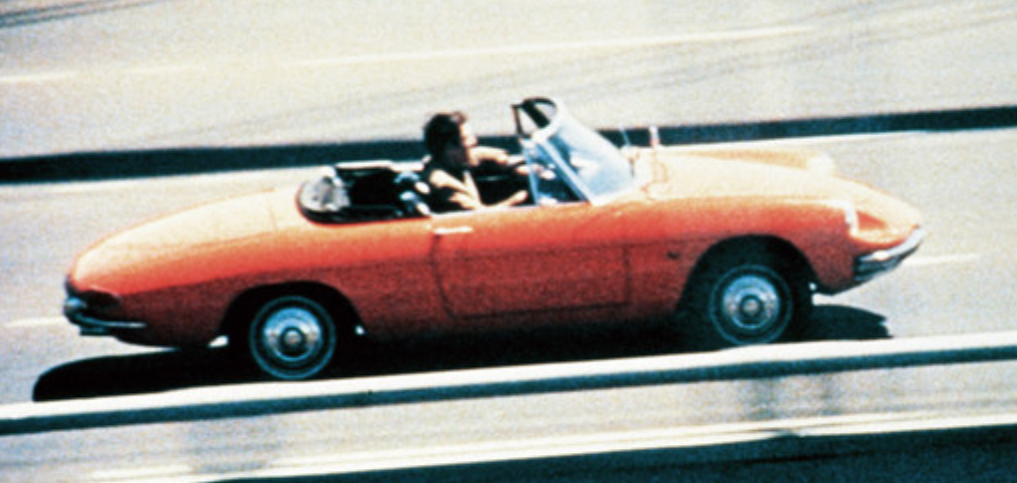
Photo credit: MovieStillsDB.com
-
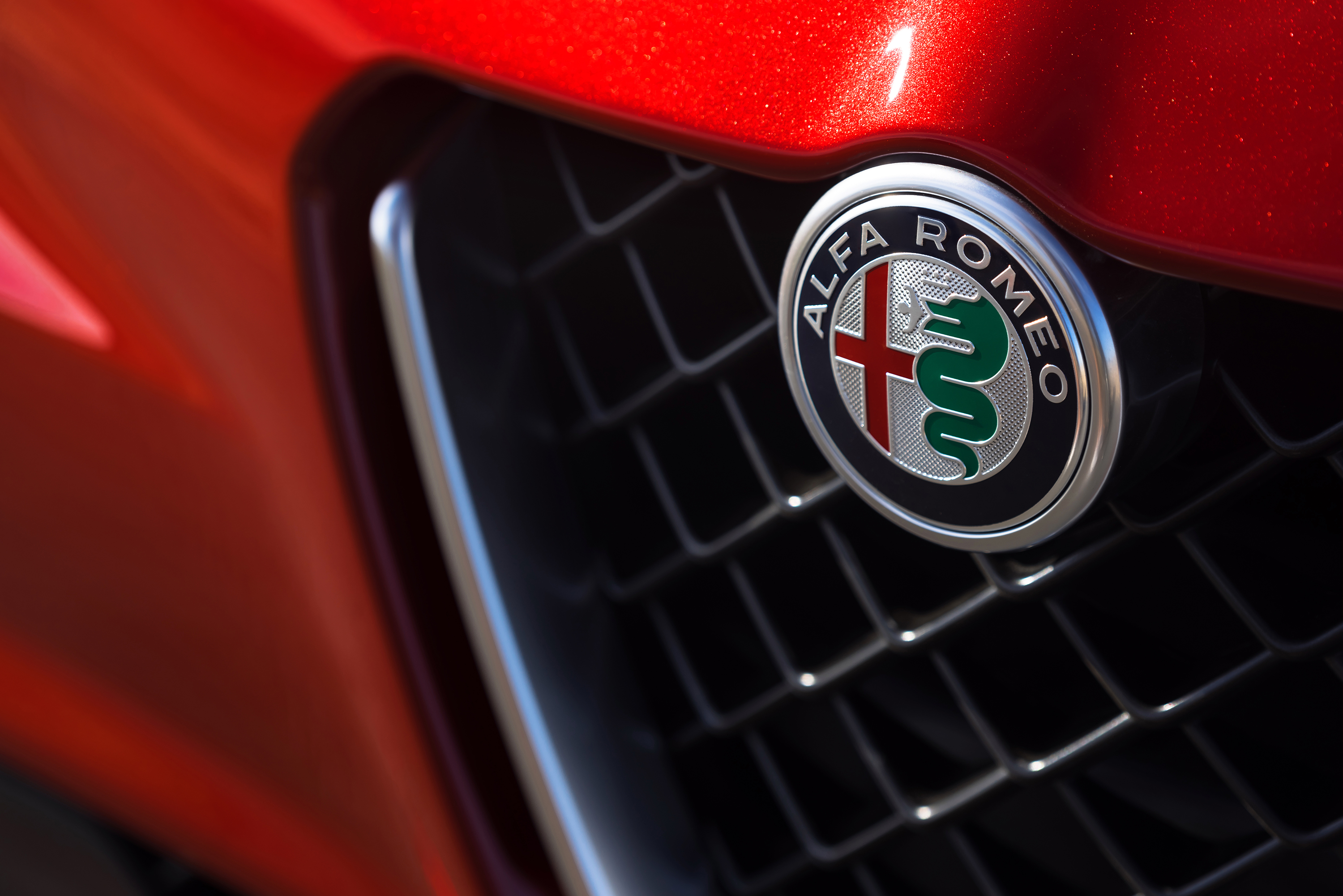
Photo credit: FCA
Alfa’s badge is composed of two primary elements, the Milanese cross and the Visconti serpent. The former pays tribute to the brand’s birthplace, while the latter is from the coat of arms of the Visconti family that ruled Milan until the 15th century. While other historical documents assert that this is a snake eating a “Saracen” (an outdated term for an Arabian), Alfa says that it’s more accurate that it’s a man being birthed from the mouth of the snake, “purified and renewed.”
Alfa’s Competition
FCA calls Alfa Romeo a “premium” brand, as opposed to the “luxury” Maserati brand. What the means for consumers is that Alfa competes against the lower end of the lineups of the established luxury brands, in segments that have been called “entry luxury” and “near luxury,” like the Audi A3 and A4. Maserati targets the upper ends where the A6 and A8 play.
The Audi comparison can also be useful from a utility perspective, where Alfa will compete primarily against the Q3 and Q5, though the brand’s planned full-size utility will go up against the Q7. Maserati already has a model in this size class, the Levante, but it’s aimed at the higher end of the market, vehicles like the Porsche Cayenne and performance versions of entries from BMW and Mercedes, like the X5 M and GLE 63, which are beyond the $100,000 mark.
Consumers who are shopping the following brands might also want to consider Alfa:
- BMW
- Audi
- Mercedes-Benz
- Porsche
- Lexus
- Acura
- Infiniti
- Cadillac
- Jaguar
Pricing and Availability:
The Giulia and Stelvio are in dealerships now. The Giulia starts at $39,440 with destination, while the Ti adds $2,000. Either can be had with AWD for another $2,000, while the top dog Quadrifoglio starts at $75,295.
The Stelvio starts at $43,240, plus $2,000 for a Ti, and the Quadrifoglio starts at $81,390.